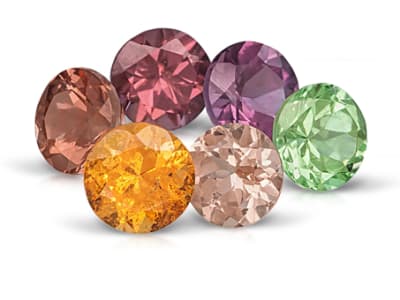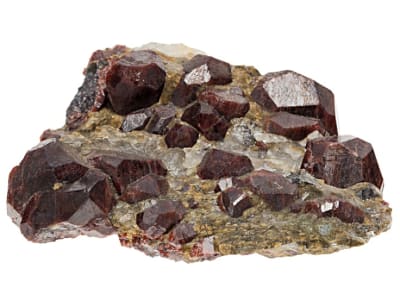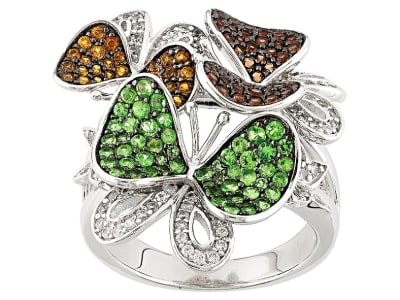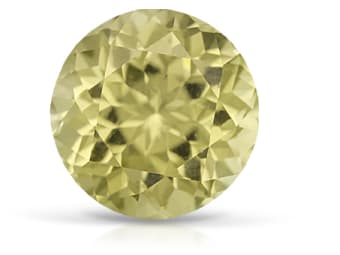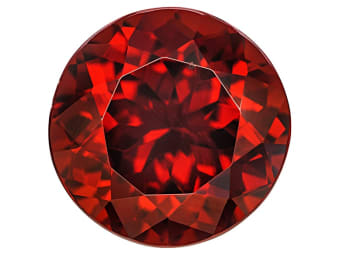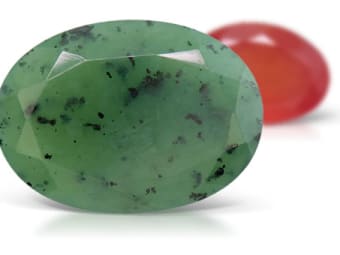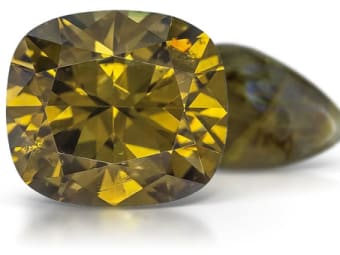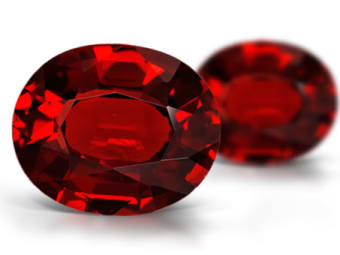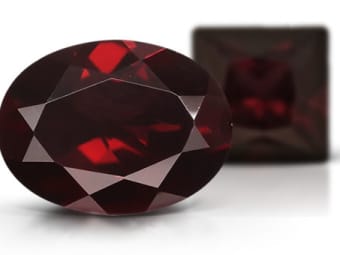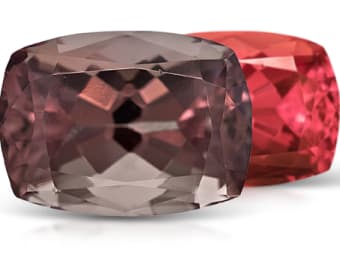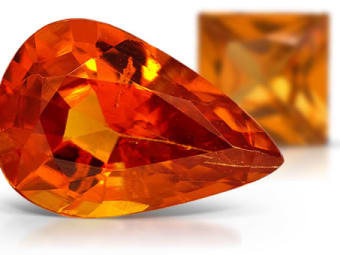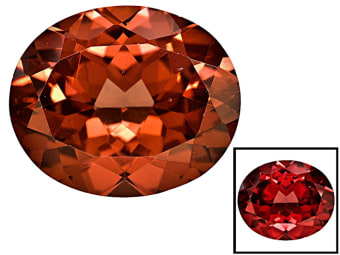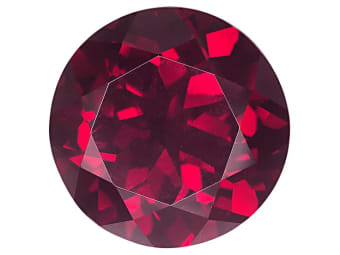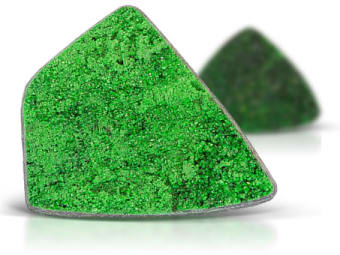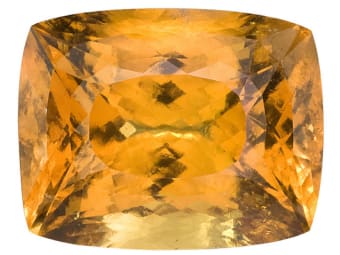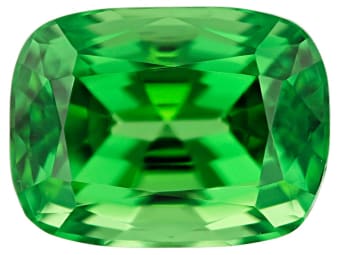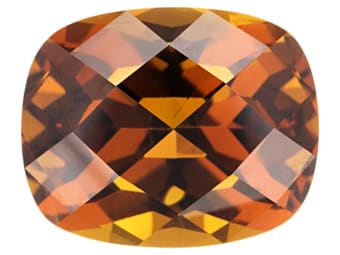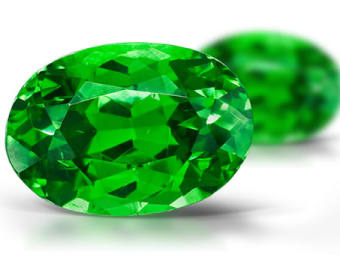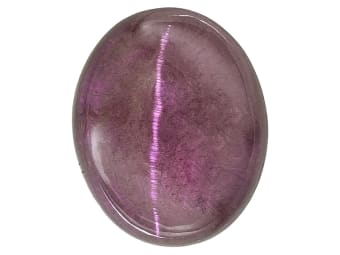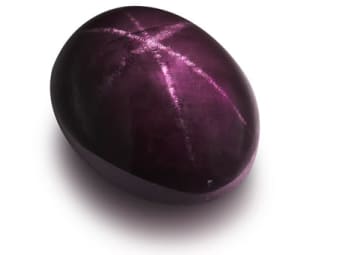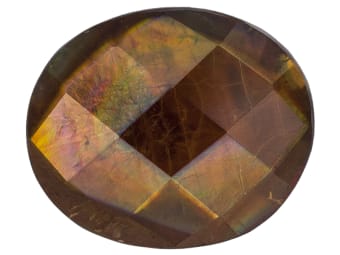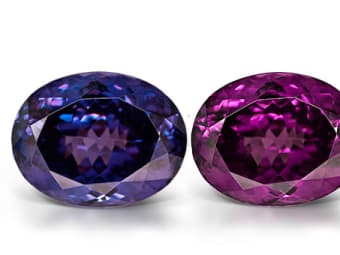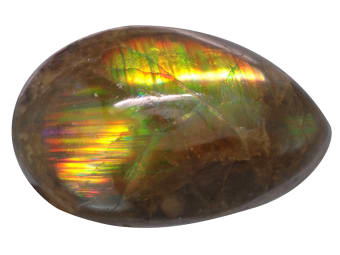Garnet is the January birthstone and has long been known in the jewelry trade. When most people think of garnets they think of brownish red to red stones, but garnets actually come in every color of the rainbow. Garnet is a group of minerals that is made up of six species: pyrope, almandine, spessartine, grossular, andradite, and uvarovite. All garnets crystallize in the cubic system, but the chemical compositions vary. To complicate things ever further some of the garnet varieties are made up of multiple garnet series, for example the pyralspite garnets are made up of pyrope, almandine and spessartine. There are more than 20 varieties of garnet.
General Information
Tolerance:(+0.030/-0.030)
LWUV: Inert
Garnet Colors
-
 Black
Black -
 Blue
Blue -
 Brown
Brown -
 Brown
Brown -
 Brown
Brown -
 Colorless
Colorless -
 Gray
Gray -
 Green
Green -
 Green
Green -
 Green
Green -
 Multi-color
Multi-color -
 Orange
Orange -
 Orange
Orange -
 Orange
Orange -
 Pink
Pink -
 Pink
Pink -
 Pink
Pink -
 Pink
Pink -
 Pink
Pink -
 Pink
Pink -
 Pink
Pink -
 Purple
Purple -
 Purple
Purple -
 Purple
Purple -
 Purple
Purple -
 Red
Red -
 Red
Red -
 Red
Red -
 Red
Red -
 Red
Red -
 Red
Red -
 Red
Red -
 White
White -
 Yellow
Yellow -
 Yellow
Yellow -
 Yellow
Yellow -
 Yellow
Yellow -
 Yellow
Yellow
Garnet Spectra
We acknowledge the significant scientific contributions of John S Harris, FGA to the study of gemstone spectra and with deep appreciation to him, acknowledges the use of his images and related notes about gemstones and their spectra in the educational materials on this website.
Countries of Origin
Tanzania, United Republic Of; Myanmar; Afghanistan; Russian Federation; United States of America; Madagascar; Thailand; Austria; Mongolia; Mozambique; Pakistan; Morocco; Unknown; Mali; China; Brazil; Nigeria; Sri Lanka; Japan; Zambia; Kenya; Switzerland; Congo; French Polynesia; India; Canada; Norway; Namibia; Italy; Mexico; South Africa; Australia; Ethiopia
Care
Normal Care
Species/Variety
Topazolite
Topazolite is an Andradite Garnet that is yellow or brownish in color. It has a similar appearance to Topaz an the resemblance inspired its name.
Melanite Garnet
Melanite is an extremely rare opaque jet-black variety of andradite garnet. The high luster of this gem, when faceted, makes the stone look like black glass. Melanite was extremely popular in Victorian period mourning jewelry.
LWUV: Inert
Malaia or Malaya Garnet
Discovered in the mid 1960's in Tanzania's Umba Valley, this red-orange to pink-orange variety of garnet was originally thought to be spessartite garnet. Actually a mixture of pyrope and spessartite, malaia garnets are lively gems that exhibit sparkling red flashes. Once discovered not to be spessartite, it soon became known by the Swahili word malaia, meaning "out of the family." Malaia garnets are available in numerous shades of orange, ranging from soft peach to intense reddish orange.
LWUV: Inert
Hydrogrossular Garnet
Hydrogrossular garnet is typically translucent to opaque and is usually available as cabochons, but on rare occasion may be found as transparent, faceted gemstones. Generally seen as green to blue-green, pink, white, and gray, this gemstone may contain small dark gray to black inclusions and may look similar to jade if opaque. Hydrogrossular is a variety of grossular garnet where hydroxide partially replaces silica.
Tolerance:(+0.010/-0.050)
LWUV: Inert
Andradite Garnet
Andradite garnet is a member of the ugrandite garnet series. Demantoid, melanite, rainbow andradite, and topazolite are varieties of andradite garnet. The stones can be yellow, green, brown, brownish red and yellow, grayish black and black. It is named after the Brazilian geologist José B. de Andrada e Silva. Andradite makes spectacular gems that display greater color dispersion than diamond.
LWUV: Inert
Almandine Garnet
Though they all have the same cubic crystal structure (like diamond and spinel), garnet is an entire group of minerals that vary in their chemical composition, resulting in a variety of gems featuring different colors and properties. Though some varieties of red garnet are common and found on nearly every continent on Earth, other garnets like orange spessartine, green demantoid and tsavorite, are much less abundant. There are more than 20 garnet species, but the five most important include pyrope and almandine (the combination of which creates rhodolite), spessartine, or grossularite (which includes hessonite and tsavorite), and andradite (which includes demantoid). Garnets of all species are the birthstone for January, so January babies aren't limited to the well-known red varieties.
Tolerance:(+0.030/-0.030)
LWUV: Inert
Pyrope Garnet
Hear the word "garnet," and what invariably comes to mind is the image of the deep red pyrope garnets belonging to the pyralspites family. Pyrope comes from the Greek words pyr and ops, meaning "fire eye." Pyrope is almost always red but can come in purplish red. Stones from Arizona are called anthill or chrome garnet.
Umbalite Garnet
Umbalite also known as Malaya (Malaia) garnet. Umbalite is a relatively new member of the garnet group. First noticed in the 1960s, it was mixed in with parcels of rhodolite garnets from the Umba River Valley in East Africa. In the beginning, many buyers rejected the material, so local miners and dealers gave it the Swahili name of “Malaya”, which translates to “out of the family”. Testing eventually confirmed that this new gem was a mixture of pyrope and spessartite garnet. Its lively color ranges from light to dark pinkish, red, and yellowish orange. After overcoming initial objections, it carved a small, but dedicated niche in the market in the 1980s, particularly in the U.S. Today, umbalite is one of the more expensive garnets and its only known sources are Kenya and Tanzania.
Spessartine Garnet
While it was once just a collector's gem, spessartine, an orange variety of garnet, made its move into the mainstream during the 1990s when new deposits were discovered in Africa. Like most garnets, spessartine is typically untreated, so the beautiful color and clarity that you see in them is just as nature created it. Spessartine garnet is named after its first discovery in Spessart, Bavaria, in the mid 1800's.
Spessartine-Pyrope Garnet
Stones in the garnet group often are an intermixture of garnet species. Spessartine-Pyrope stones are composed primarily of these two varieties with minor amounts of almandine and grossularite. The stones can be light to dark, slightly pinkish orange, reddish orange, yellowish orange, blue, teal, greenish blue, pink, red and purple. Stones often show color change or color shift phenomena. The stones are sometimes sold as “Malaya” garnet.
Pyrope-Almandine Garnet
Stones in the garnet group often are an intermixture of garnet species. Pyrope-Almandine stones are composed primarily of these two garnet varieties. When pyrope-almandine stones have a purple component, they are known as Rhodolite. Stones can be orange red to brownish red and dark red, light to dark purplish red through reddish purple.
Uvarovite
Uvarovite is a highly desirable, yet widely unknown garnet species. Discovered in the 1830's in Russia, it was named in honor of Count Sergey S. Uvarov, a 19th century Russian statesman, scholar and avid mineral collector. Especially prized by collectors, uvarovite is hard to find anywhere, especially in sizes greater than 0.25 carats. Uvarovite ranges in color from medium to dark green and is best known for its granular, drusy masses which reveal well-formed dodecahedral or trapezohedral crystals under magnification.
Grossularite
The first grossular garnet specimens discovered were pale green and similar in color to the gooseberry. This species of garnet gets its name from the Latin name for gooseberry "Grossularia". Not all grossular garnets are green. Most grossular garnets are better known by their variety names hessonite, tsavorite, mint, leuco garnet, and hydrogrossular.
Rosolite, Landerite or Xalostocite
Rosolite which is sometimes called landerite or xalostocite is found in Sierra de Cruces, Mexico. It is the translucent to opaque variety of grossular garnet found in marble.
Hessonite Garnet
Nicknamed the "cinnamon stone", hessonite is a variety of grossular garnet and comes in two colors, golden and cinnamon. A perfectly colored hessonite is a bright golden orange that resembles a combination of honey and orange with an internal fire. Some hessonites have tints of red and brown with cinnamon appearance. Hessonite is common in the gem gravels of Sri Lanka and practically all hessonite is obtained from this locality, although it is also found in Africa. While the clearest gems are most prized, inclusions in hessonite are common, with unique toffee-like streaks giving hessonite an oily or even glass-like appearance.
Tsavorite Garnet
Tsavorite is one of two green varieties of garnet, though arguably the more important of the two. Especially in smaller sizes, tsavorite creates competition for emerald because it is less included, rarely treated and more durable. Like some emerald and green tourmaline, tsavorite garnet owes its green hues to the presence of vanadium and chromium. First discovered in Tanzania in 1967 and a few years later in Kenya, tsavorite's name pays homage to the nearby Tsavo National Park.
Mali Garnet
Mali garnet is a grossularite-andradite garnet. It is sometimes sold as grandite. Mali garnets can be lightly greenish yellow, intense green to brown-orange or dark orangy brown.
Demantoid Garnet
Demantoid garnet is one of the most desirable of all colored gemstones and extremely rare. A color variety of andradite garnet, the name demantoid originates from the old German word demant meaning "diamond-like," because of a luster and dispersion that yields a fire even higher than diamonds.
Optical Phenomena
Star and Cat's-Eye Rhodolite Garnet
Star or cat’s-eye rhodolite garnet exhibits optical phenomenon when light within the gem reflects off the rutile inclusions, creating narrow bands of light. When two or more intersecting bands appear, a star pattern is formed. Depending on the crystal, the star may have four or six rays. Stones have been reported with diasterism where both a 4-ray and a 6-ray star can be seen depending on the light orientation. The phenomenon comes from needle-like inclusions oriented at 70 and 110 degrees angles. When only one band forms, it is classified as a "cat's eye". Rhodolite star garnet comes from Kangala Mine, in the Tiriri mining district, Tanzania. The largest stone found from the Kangala Mine is 15.60ct.
LWUV: Inert
Star Almandine Garnet
Star or cat’s-eye almandine garnets exhibit the optical phenomenon called asterism, a star-like pattern created on the surface of a gemstone when light encounters parallel fibrous, or needle-like, inclusions within its crystal structure. Rutile inclusions are responsible for most star almandine garnet except for stones from Madagascar which have oriented sillimanite inclusions. There have been suggestions that hornblende inclusions can also produce stars. Star almandite can be found in Brazil, India, Madagascar, Sri Lanka, Tanzania, United States of America, Vietnam. The Smithsonian has two Idaho star almandines in their collection. Stars commonly have four rays but can have six rays. Rare stones from Sri Lanka will produce a Cat’s-Eye effect, but these do not get above 6 carats. Star almandite garnet is usually dark and can be reddish purple to reddish orange often with a brownish tone.
Tolerance:(+0.030/-0.030)
LWUV: Inert
Rainbow Garnet
Also called "rainbow garnet," this gray to deep brown garnet displays phenomenal iridescence. The iridescence is caused by the way grossular and andradite garnet are mixed together in this single gem, forming a crystal structure that both scatters and traps light within the gem, creating a myriad of colors.
LWUV: Inert
Color-Change and Color-Shift Garnet
Color change and color shift garnets are among the rarest, most interesting of all gemstones. This phenomenal gem is in fact a mixture of garnet species. You can observe color change in this gem by viewing it interchangeably in natural and incandescent light. Color change garnets from Madagascar and Tanzania have distinct color change from green to bluish green in daylight or fluorescent light and red to reddish purple in incandescent light. Color change stones are also known to come from Sri Lanka. Madagascan color shift stones are greenish yellow in daylight and intense pink to red in incandescent light. Color shift stones from Kenya and Tanzania change from greenish-yellowish brown in transmitted fluorescent light to purplish red in reflected fluorescent light or reddish orange in transmitted light and red in reflected incandescent light.
LWUV: Inert
Cat’s-Eye andradite
Cat’s-Eye andradite garnet known as rainbow garnet is rare but has been found from the Kouse Magnetite Mine Tenkawa, Yoshino, Nara Province Japan, Sonora Mexico, and the United States. The iridescence is caused by thin film interference. The 4-ray Sonora Mexican material shows iridescence parallel to the crystal faces. The cat’s-eye Demantoid variety was first found in Zermatt, Switzerland.
